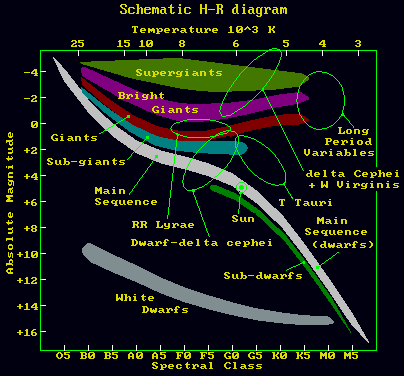What is a Star
At the simplest, a star is just a ball of gas that has condensed out of interstellar material. The largest part of its lifetime is spent as a main sequence star during which hydrogen is being converted to helium balancing gravitational contraction so that the radius and energy output remain almost constant. More massive stars convert hydrogen faster and have much shorter lifetimes than smaller stars. The Sun is ‘mid-range’ and has already spent about 5,000,000,000 years on the main sequence. Drastic changes will not occur until a further similar period of time has elapsed, so it is now roughly halfway through it’s career. The most massive stars probably go through the main sequence phase in about a million years, whereas least massive stars (about 8% of the Sun’s mass) formed in the early universe could still be frugally converting their meagre supply of hydrogen now.
Although the main stellar constituent is hydrogen, the small amounts of the other elements vary depending on the interstellar medium where the star formed. Late in their lifetimes, many stars return heavier elements back to the interstellar medium. Hence stars forming now have a higher percentage of heavy elements than ancient stars formed when the universe was younger.
Spectral types
Astronomers can find the relative abundance of elements by studying the patterns of absorption and emission lines in stellar spectra. The surface temperature and composition of a star determine its spectrum and spectroscopy is an important part of the work carried out on professional telescopes. Stars are classified according to their spectra into 7 main sequence classes;-
O B A F G K M
These classes correspond to the temperature or Colour Index of the star’s surface, O = blue-white, 100,000 Kelvin; A = white, 11,000 K; M = red, 3000 K. Each class is further subdivided by adding the numerals 0 to 9, so O0 is the hottest of type O, and M9 the coolest in class M, the Sun being a G2 star.
A small number of stars (about 1%) are placed in side classes, so at the high temperature end are W, P, Q, and at low temperatures are C, & S where C now supersedes older classes R & N. Type W = Wolf-Rayet stars which have temperatures equal to type O but their colour appears cooler. Their spectra have bright emmission bands of hydrogen and helium and they are ejecting material at high velocities. Type P = gaseous nebulae, type Q = Novae, and the cool branches C & S, (also R & N) have different molecular bands in their spectra than M stars.
It used to be thought that stars progressed from hot to cold and O, B, A, are sometimes referred to as ‘early’ types whereas K, M, C, (N, R), S are called ‘late’.
Perhaps showing that astronomers often have a ‘down-to-Earth’ sense of humour, the older sequence of classes can be remembered by the oft-quoted mnemonic;-
Wow! Oh, Be A Fine Girl, Kiss Me Right Now, Smack!.
Magnitude
The brightness of stars is measured in magnitudes where a difference of 5 magnitudes equals a 100-fold difference in brightness. One magnitude therefore corresponds to a brightness ratio of just over 2.5. The scale is ‘reversed’ so that fainter stars have greater numerical magnitudes and the scale is extended to minus values for bright stars. Hence, the brightest star Syrius is -1.44m, and with the unaided dark-adapted eye on a clear night, stars down to about 6.0m can be seen. (the + sign being assumed if omitted)
The apparent magnitude (m) is the brightness as seen from Earth without regard to stars at different distances, whereas the absolute magnitude (M) is a measure of the intrinsic luminosity – how bright the star would look if it were 10 Parsecs away. (32.6 light-years)
Hertzsprung-Russell Diagram
This is a plot of spectral type (or colour index, temperature) on the x-axis versus the luminosity (absolute magnitude) on the y-axis.
Over 90% of all stars fall into the broad main sequence band running from top-left to bottom-right, but other groupings are also evident. Some of these groups are populated with specific types of variable star which precede or follow the main sequence phase of stellar evolution. Hence, T Tauri and RW Aur stars are settling down towards the main sequence whereas Delta Cephei and RR Lyrae stars are traversing an instability region in the HR diagram which marks the end of hydrogen-helium synthesis and the start of processes that convert core helium to higher elements. Observations of variable stars therefore provide data for studying the periods in a star’s life when it is evolving rapidly on stellar time-scales.
| The British Astronomical Association supports amateur astronomers around the UK and the rest of the world. Find out more about the BAA or join us. |
